Online Coordination of Plug-In Electric Vehicles Considering Grid Congestion and Smart Grid Power Quality
Abstract
:1. Introduction
1.1. Motivation
1.2. Literature Survey
1.3. Contributions
- A New Nonlinear PEV Coordination Approach. The proposed online coordination approach (OL-MSSCA) considers the nonlinearities of the EV battery chargers and industrial loads. This is due to the importance of power quality standards in the field of smart grids and online scheduling approaches. The online PEV coordination approaches available in the literature ignore the impacts of harmonics and poor power quality in the reported online scheduling programs. To consider this gap, this paper uses the application of the DHPF algorithm to model the nonlinear loads and the nonlinear EV chargers in the formulation of the objective function to minimize the total cost, improve the power quality and performance of the smart grid. Accordingly, the nonlinear OL-MSSCA will control the THDv level (considering utilities’ concerns) by including the THDv in the objective cost, while also satisfying the PEV owners’ preferences (considering priority zones). The new proposed objective function is formulated based on the harmonic power losses extracted from the MSS vector, which is easily extracted from the existing Jacobian matrix of the DHPF algorithm. Therefore, the proposed approach is relatively simple, fast and practical.
- A Simple and Practical Strategy to Relieve Grid Congestion. The new online algorithm can successfully keep the THDv level within the permissible standard of limit of 5% and fully charge PEVs for medium and moderate PEV penetrations. This is done by shifting some of the PEV charging activities to off-peak hours. However, the algorithm may not be able to simultaneously manage to control the THDv and customer satisfaction with high PEV penetration. This is due to the inclusion of a THDv operating condition in the objective cost function and constraints in order to avoid any THDv violations. Therefore, a simple solution consisting of PPF installation is proposed for further improvement of power quality and satisfying the demands of PEV owners. The PPFs are designed and tuned on dominant harmonic spectrums. The new control strategy is now capable of fully charging the PEV by the next morning and controlling the THDv.
- Solution Validation and Assessment. The proposed OL-MSSCA algorithm was tested on a distorted and modified smart grid system and the results are assessed through 3 case studies. Comparison of the 3 case studies indicates that uncontrolled PEV activities (case 1) may lead to severe power quality issues (for example, for 47% PEV penetration, THDv is above 11% with high voltage deviations and losses) whereas the new proposed algorithm (case 3) can successfully keep the THDv level within the designated permissible limit, even with high PEV penetrations of 47% and 64%. Also, all PEVs are fully charged and ready for their next trip.
1.4. Organization of Manuscript
2. Formulation of PEV Coordination Problem Considering Battery Charger and Nonlinear Load Harmonics
2.1. Decoupled Harmonic Power Flow Calculation
2.2. Proposed Nonlinear Online Maximum Sensitivity Selection Based Charging Algorithm (NOL-MSSCA) for Coordination of PEVs in a Smart Grid
- PEV coordination is performed to reduce the costs associated with generation and losses considering the network, EVs and power quality constraints.
- The DHPF algorithm is included in the PEV coordination approach to add the harmonic injections of nonlinear EV battery chargers and nonlinear industry loads.
- Consumers with PEVs are classified as high, medium and low priority customers. These priorities are defined based on three different charging zones: (i) Red/high priority (1800–2200h) customers tend to charge their vehicles as soon as they return from work and pay very high tariffs. (ii) Blue/medium priority (2200–0100h) PEV owners prefer to charge their vehicles at partially off-peak periods with lower tariff rates. (iii) Green/low priority (0100–0800h) customers charge their vehicles during off-peak hours and is highly recommended because low tariffs are set for customers.
- Most EVs users are charged based on their priorities as they are randomly plugged-in to increase consumer satisfaction.
- Charging of the remaining EVs are postponed and shifted to off-peak hours during early-morning hours to decrease the cost and keep the power quality constraints within the permissible limits as recommended by the IEEE-519 standard [18].
- For the scenarios with moderate and high levels of PEV penetrations, the OL-MSSCA algorithm may not be able to fully charge the EVs, especially during peak hours due to THDv violations. According to IEEE standard 519, the THDv level needs to be kept within the permissible level of 5%. Note that OL-MSSCA strictly prevents any THD and/or voltage quality violations. Therefore, no cost or penalties for THDv increases and violations are considered in the proposed PEV coordination approach. Instead, THD issues at high PEV penetration levels are resolved by the installations of inexpensive PPFs.
- To fully charge the PEVs, a simple approach using PPF installation is considered.
2.3. Formulation of Proposed NOL-MSSCA for PEV Coordination
3. The Modified Smart Grid Test System with PEVs
4. PEV Battery Charger as Nonlinear Load
5. Simulation Results and Discussions
6. Discussions
6.1. Case 1—Uncoordinated PEV Charging
6.2. Case 2—PEV Coordination with NOL-MSSCA
6.3. Case 3—Installation of Passive Power Filters (PPFs) to Improve the Performance of NOL-MSSCA with High Penetration of PEVs
7. Conclusions
- Uncoordinated charging of PEV batteries (case 1) could have negative impacts on the performance and power quality of a smart grid. It could result in unacceptable THDv levels beyond the permissible limits of the IEEE-519 Standard, particularly at high penetrations of EVs during peak-load hours. Table 2 and Figure 5 indicate that the system’s THDv level is above 11% for a high PEV penetration of 47%.
- The proposed NOL-MSSCA managed to charge all EVs at low and moderate levels of PEV penetration without exceeding the power quality limits. The NOL-MSSCA minimizes the costs associated with generation and losses while controlling system overload and bus voltage regulations as well as the bus and network voltage THDs. Simulation results for case 2 (Table 2 and Figure 6) reveal that the proposed algorithm can manage to reduce the THDv level to approximately 5% for 16% and 32% PEV penetrations and fully charge the PEVs. However, at very high penetrations of PEVs with significant charger and nonlinear load harmonic current injections, particularly during peak-load hours, the NOL-MSSCA could not fully charge all PEVs before the designated time of 0800h for the next day’s trip. As shown in Table 2 and Figure 6, the THDv level is reduced from 11.6% to 5.36% for a high PEV penetration of 47%. However, 20 PEVs were not charged by 0800h.
- To resolve the issues and meet the need for customer satisfaction, the simple approach of installing PPFs installation at the worst voltage quality buses is suggested (case 3). Simulation results show the good performance of NOL-MSSCA with passive filtering for the PEV penetration of 47%. Therefore, this practical approach successfully managed to fully charge all PEVs before their next trip in the morning, even with high PEV penetrations. According to the results of Table 2 and Figure 7, the THDv for high PEV penetrations is within the permissible standard level of 5% while all PEVs were fully charged.
- The proposed practical approach of this paper can also be applied in other PEV coordination technologies by considering harmonics in the objective function and constraints.
- For the cases with high PEV penetrations, a more sophisticated filtering approach could be considered, such as the installation of active power filters (APFs) or custom power devices (CPDs) at selected buses with poor power quality.
- For the cases with high PEV penetrations, rescheduling of SSCs can also be investigated for further power quality improvement.
Funding
Acknowledgments
Conflicts of Interest
Nomenclature
| A. Acronyms | |
| APF | Active Power Filter |
| ASD | Adjustable Speed Drive |
| CDP | Custom Power Devices |
| DCFC | DC Fast Charging |
| DHPF | Decoupled Harmonic Power Flow |
| DG | Distributed Generation |
| EV | Electric Vehicle |
| LTC | Transformer Load Tap Changer |
| MSS | Maximum Sensitivity Selection |
| NOL-MSSCA | Nonlinear Online Maximum Sensitivity Selection based Charging Algorithm |
| PEV | Plug-in Electric Vehicle |
| PPF | Passive Power Filter |
| PWM | Pulse Width Modulation |
| SSC | Switched Shunt Capacitor |
| THD | Total Harmonic Distortion |
| THDv | THD of Voltage |
| VFD | Variable Frequency Drive |
| VSD | Variable Speed Drive |
| B. Indices, Parameters and Variables | |
| C(h) | Ratio of the hth harmonic current to its fundamental |
| C(h)F= | Tuned filter capacitor at harmonic h |
| Dtcore,total | Total system demand |
| Dt,cor,max | Maximum demand level (without any PEVs) at time interval t |
| f1 | System fundamental frequency; f1 = 50 Hz |
| fh | Harmonic h frequency; fh = h(f1) |
| Fcost (loss + demand) | Objective function of the proposed NOL-MSSCA algorithm |
| H | Highest harmonic order considered |
| KT | Cost per MWh of losses (for example, 50$/MWh [19] |
| KG | Cost per MWh of generation [20] |
| P | Real power |
| Harmonic power losses in the line between busses i and i + 1 | |
| Total system power losses (including fundamental and harmonic losses) | |
| Pt,loss | Total system power losses (including fundamental and harmonic losses) at hour t |
| Q | Reactive power |
| RF | Tuned filter resistor |
| Resistance of the line between busses i and i + 1 | |
| S | Complex power |
| dS | Partial derivative of S with respect to voltage |
| Partial derivative of S with respect to voltage magnitude | |
| Partial derivative of S with respect to voltage phase angle | |
| t | Time interval (equal to 5 min in this paper) |
| THD voltage of bus k | |
| THDvi | THD distortion at bus i |
| THDvmax | Maximum allowed THD distortion at bus i |
| V | Voltage |
| |V| | Voltage magnitude |
| Voltage phase angle | |
| V(h) | Harmonic voltage at harmonic frequency h |
| Harmonic voltage of bus i at harmonic frequency h | |
| ΔVm | The per unit (pu) voltage deviation of bus m |
| ΔVmax= 0.1 pu | Selected limited of voltage deviation |
| Vi man | Maximum limit of the harmonic rms voltage at bus i |
| Vi mix | Minimum limit of the harmonic rms voltage at bus i |
| Reactance of the line between busses i and i + 1 | |
| Capacitance of the line between busses i and i + 1 | |
| Y(h) | Admittance matrix at harmonic frequency h |
| Diagonal entries of the admittance matrix. | |
| Off-diagonal entries of the admittance matrix. | |
References
- Masoum, M.A.S.; Fuchs, E.F. Power Quality in Power Systems and Electrical Machines, 2nd ed.; Elsevier Academic Press: Burlington, MA, USA, 2015. [Google Scholar]
- Ulinuha, A.; Masoum, M.A.S.; Islam, S.M. Optimal Scheduling of LTC and Shunt Capacitors in Large Distorted Distribution Systems using Evolutionary-Based Algorithms. IEEE Trans. Power Del. 2008, 23, 434–441. [Google Scholar] [CrossRef]
- Fuchs, E.F.; Masoum, M.A.S. Power Quality in Power Systems and Electrical Machines, 1nd ed.; Academic Press: Cambridge, MA, USA, 2008. [Google Scholar]
- Ladjevardi, M.; Masoum, M.A.S. Genetically optimized fuzzy placement and sizing of capacitor banks in distorted distribution networks. IEEE Trans. Power Deliv. 2008, 23, 449–456. [Google Scholar] [CrossRef]
- Electric Vehicle Charging Station Locations. Available online: http://www.afdc.energy.gov/fuels/electricity_locations.html (accessed on 18 July 2018).
- Impact of Electric Vehicles and Natural Gas Vehicles on the Energy Market. Available online: https://mpra.ub.uni-muenchen.de/58388/ (accessed on 9 September 2014).
- Fang, X.; Misra, S.; Xue, G.; Yang, D. Smart grid—The new and improved power grid: A survey. IEEE Commun. Surv. Tutor. 2011, 14, 944–980. [Google Scholar] [CrossRef]
- Dubey, A.; Santoso, S. Electric Vehicle Charging on Residential Distribution Systems: Impacts and Mitigations. IEEE Access 2015, 3, 1871–1893. [Google Scholar] [CrossRef]
- Gomez, J.C.; Morcos, M.M. Impact of EV Battery Chargers on the Power Quality of Distributed Systems. ZEEE Trans. Power Deliv. 2003, 18, 975–981. [Google Scholar] [CrossRef]
- Basu, M.; Gaughan, K.; Coyle, E. Harmonic Distortion Caused by EV Battery Chargers in the Distribution Systems Network and Its Remedy. In Proceedings of the 39th International Universities Power Engineering Conference (UPEC), Bristol, UK, 6–8 September 2004. [Google Scholar]
- Singh, B.; Kushwaha, R. An EV Battery Charger with Power Factor Corrected Bridgeless Zeta Converter Topology. In Proceedings of the 7th India International Conference on Power Electronics (IICPE), Patiala, India, 17–19 November 2016. [Google Scholar]
- Yilmaz, M.; Krein, P.T. Review of the Impact of Vehicle-to-Grid Technologies on Distribution Systems and Utility Interfaces. IEEE Trans. Power Electron. 2013, 28, 5673–5689. [Google Scholar] [CrossRef]
- Su, W.; Rahimi-Eichi, H.; Zeng, W.; Chow, M.Y. A Survey on the Electrification of Transportation in a Smart Grid Environment. IEEE Trans. Power Deliv. 2012, 3, 1–10. [Google Scholar] [CrossRef]
- Amini, M.H.; Moghadam, P.M.; Karabasoglu, O. Simultaneous Allocations of Electric Vehicles’ Parking Lots and Distributed Renewable Resources in Smart Power Distribution Networks. Sustain. Cities Soc. 2017, 28, 332–342. [Google Scholar] [CrossRef]
- Bahrami, S.; Wong, V.W.S.; Huang, J. An Online Learning Algorithm for Demand Response in Smart Grid. IEEE Trans. Smart Grid 2017. [Google Scholar] [CrossRef]
- Bahrami, S.; Parniani, M. Game Theoretic Based Charging Strategy for Plug-In Hybrid Electric Vehicles. IEEE Trans. Smart Grid 2014, 5, 2368–2375. [Google Scholar] [CrossRef]
- Deilami, S.; Masoum, A.S.; Moses, P.S.; Masoum, M.A.S. Real-Time Coordination of Plug-In Electric Vehicle Charging in Smart Grids to Minimize Power Losses and Improve Voltage Profile. IEEE Trans. Smart Grid 2011, 2, 456–467. [Google Scholar] [CrossRef]
- Recommended practices and requirements for harmonic control in electrical power systems. IEEE Stand. 2014. [CrossRef]
- Price List Standard Fees and Charges. Available online: www.synerg.com 2018 (accessed on 1 July 2018).
- Masoum, M.A.S.; Ladjevardi, M.; Fuchs, E.F.; Grady, W. Optimal Placement and Sizing of Fixed and Switched Capacitor Banks Under Nonsinusoidal Operating Conditions. In Proceedings of the IEEE Power Engineering Society Summer Meeting, Chicago, IL, USA, 21–25 July 2002. [Google Scholar]
- Khaldi, M.R. Sensitivity matrices for reactive power dispatch and voltage control of large-scale power systems. Int. J. Electr. Power Energy Syst. 2004, 213–489. [Google Scholar]
- Civanlar, S.; Grainger, J.J. Volt/Var control on distribution systems with lateral branches using shunt capacitors and voltage regulators part III: The numerical results. IEEE Trans. Power Appar. Syst. 1985, 104, 3291–3297. [Google Scholar] [CrossRef]
- Bass, R.; Harley, R.; Lambert, F.; Rajasekaran, V.; Pierce, J. Residential Harmonic Loads and EV Charging. In Proceedings of the 2001 IEEE Power Engineering Society Winter Meeting, Columbus, OH, USA, 28 January–1 February 2001; pp. 803–808. [Google Scholar]
- Yanxia, L.; Jiuchun, J. Harmonic-Study of Electric Vehicle Chargers. In Proceedings of the 2005 International Conference on Electrical Machines and Systems, Nanjing, China, 27–29 September 2005; pp. 2404–2407. [Google Scholar]
- Steady State Vehicle Charging Fact Sheet: Nissan Leaf. Available online: http/avt.inl.gov/sites/default/files/pdf/fsev/SteadyStateLoadCharacterization2015Leaf (accessed on 1 July 2015).
- Masoum, M.A.S.; Deilami, S.; Islam, S.M. Mitigation of Harmonics in Smart Grids with High Penetration of Plug-In Vehicles. In Proceedings of the IEEE PES General Meeting, Minneapolis, RI, USA, 25–29 July 2010. [Google Scholar]
- Masoum, A.S.; Deilami, S.; Abu-Siada, A.; Masoum, M.A.S. Fuzzy Approach for Online Coordination of Plug-In Electric Vehicle Charging in Smart Grid. IEEE Trans. Sustain. Energy 2015, 1112–1121. [Google Scholar] [CrossRef]

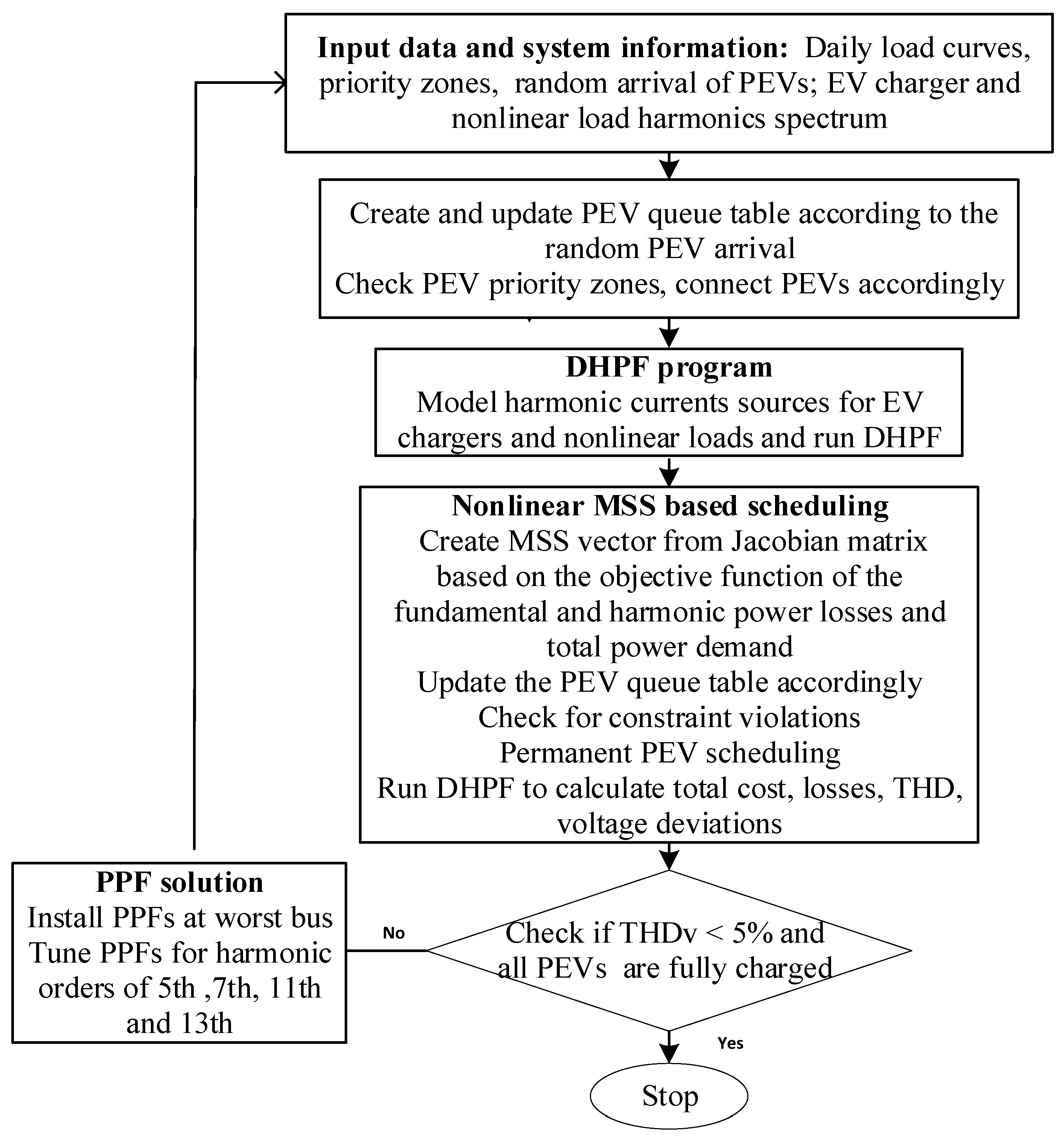
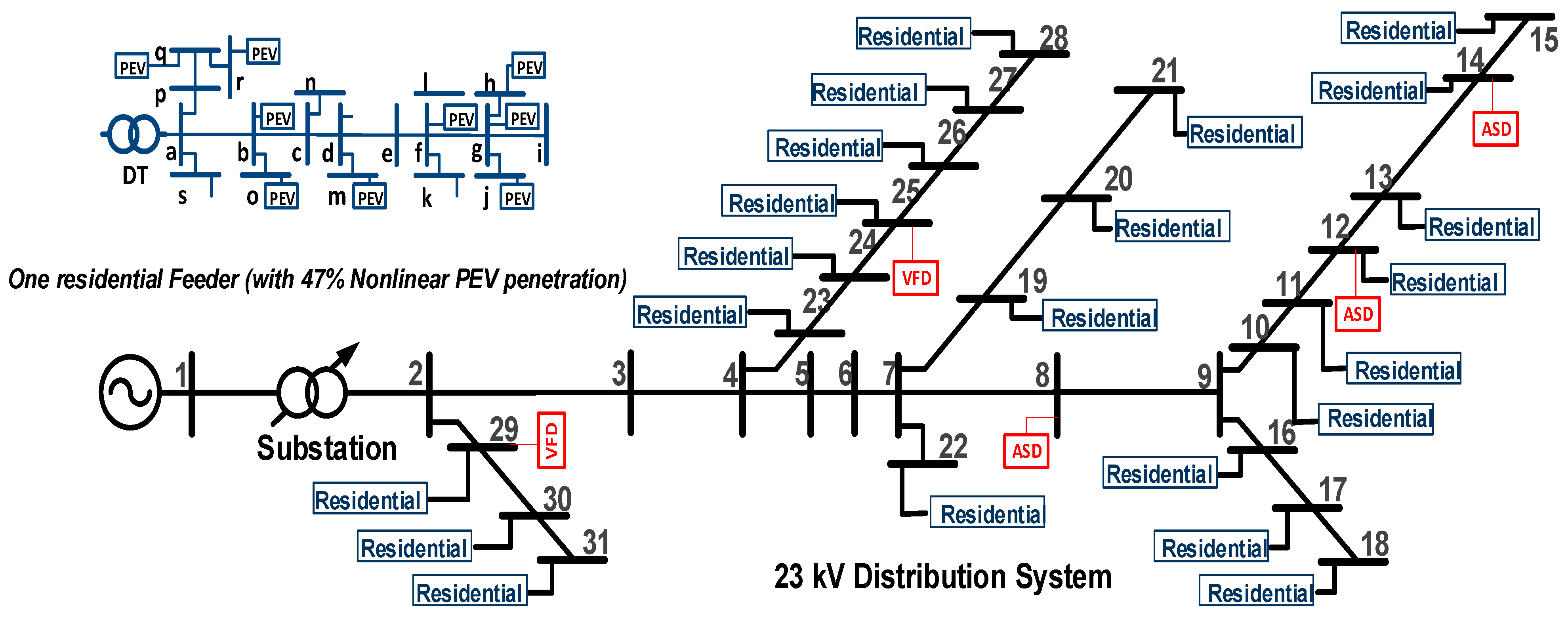
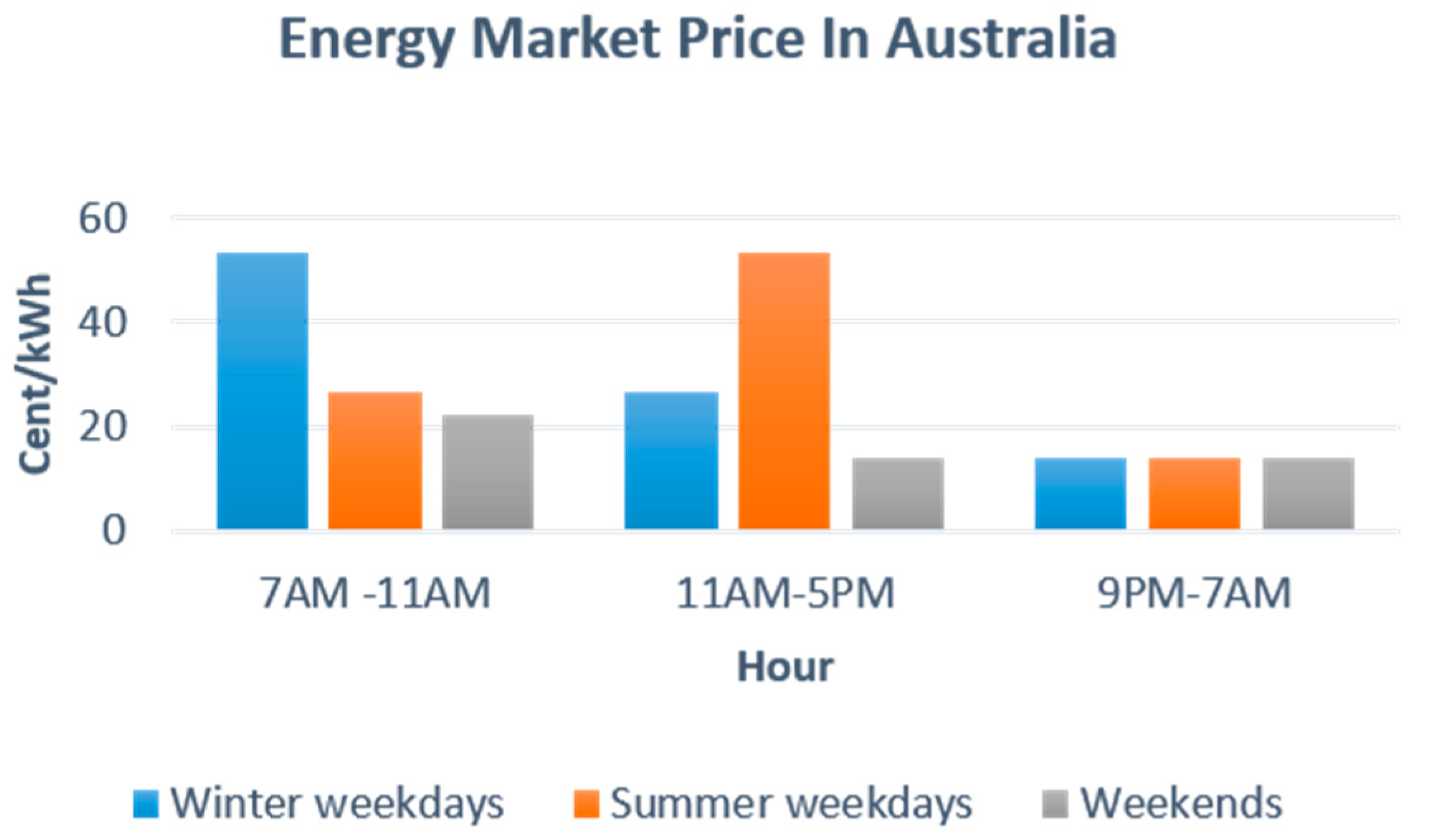
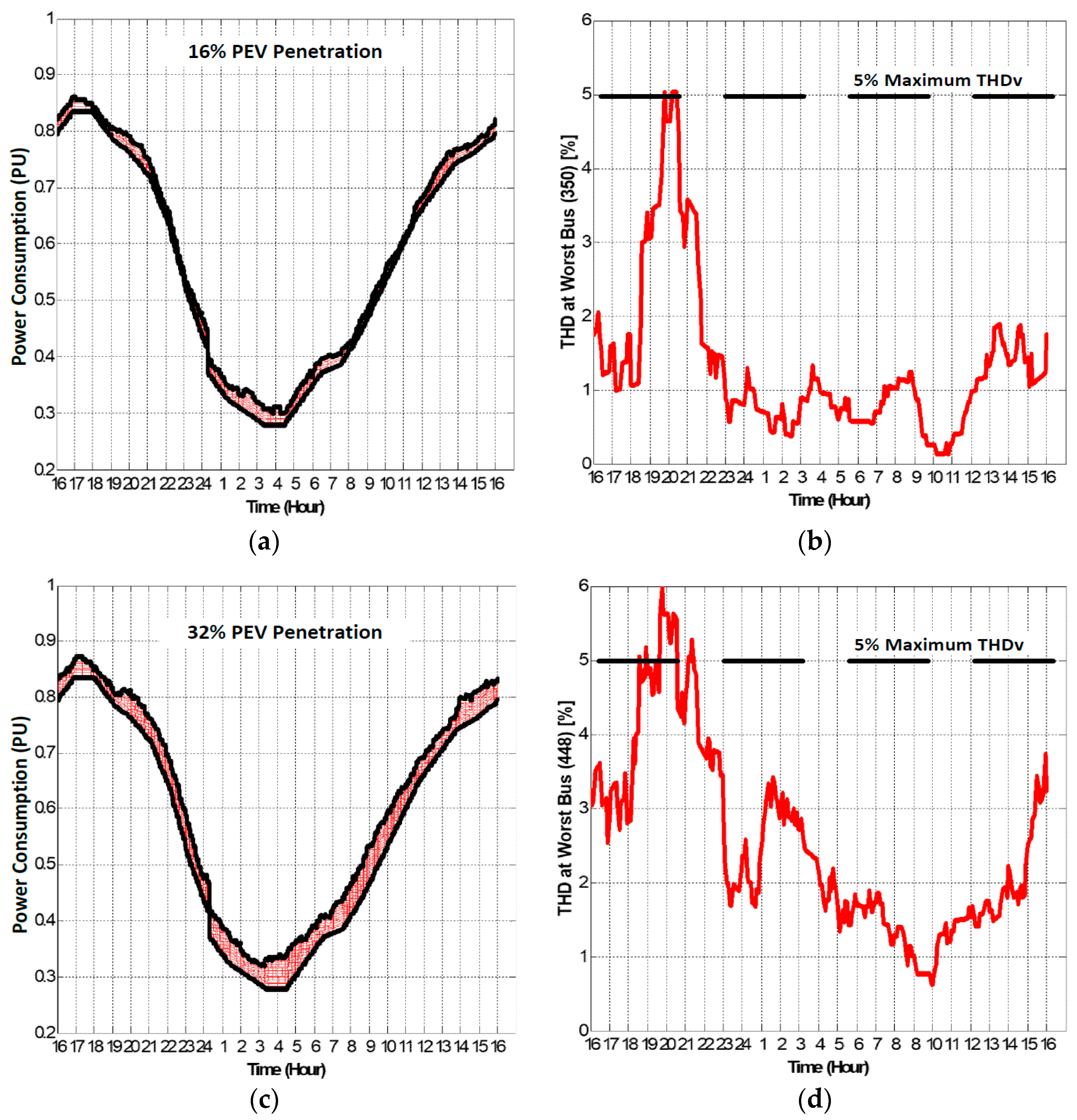


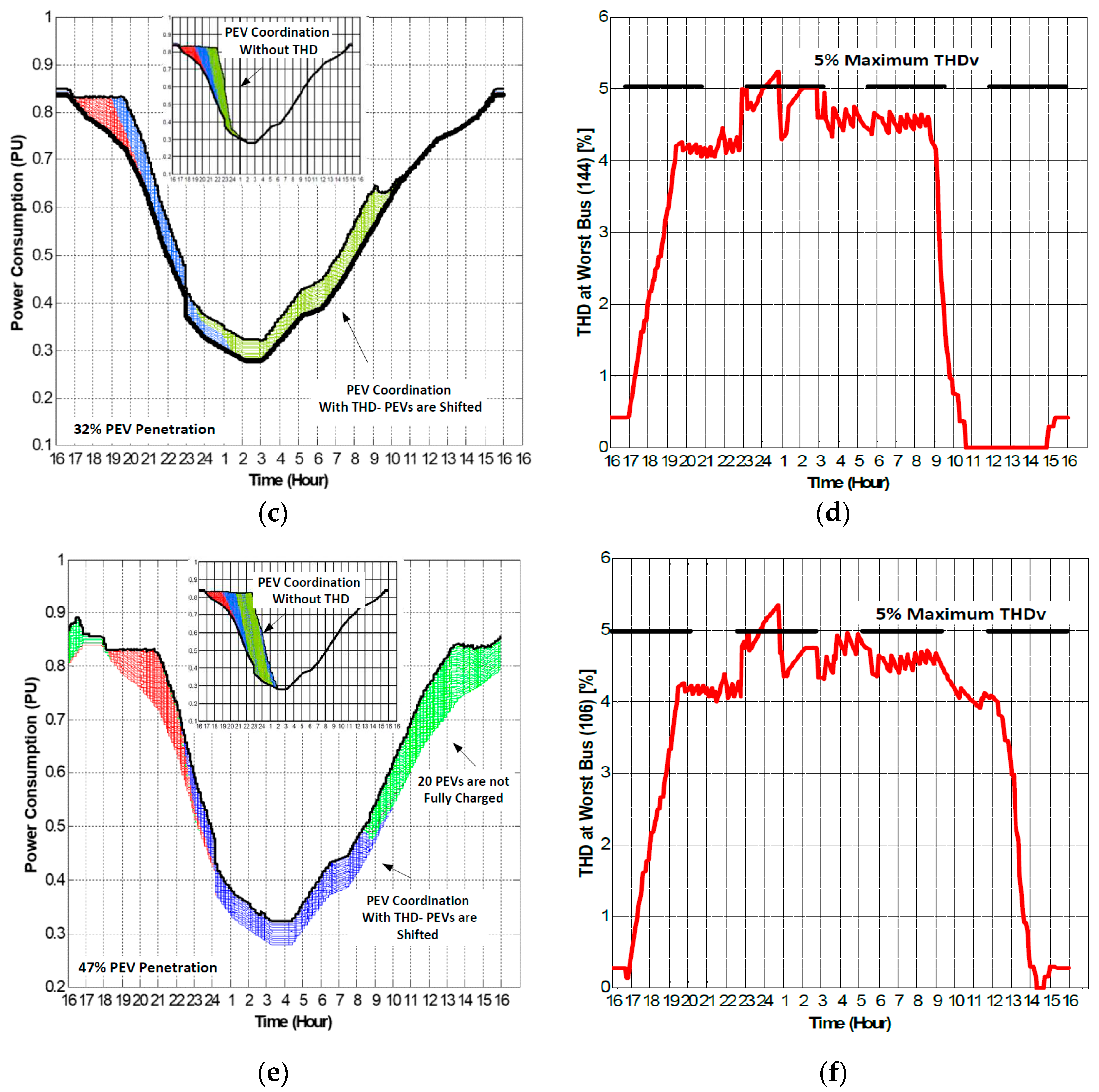
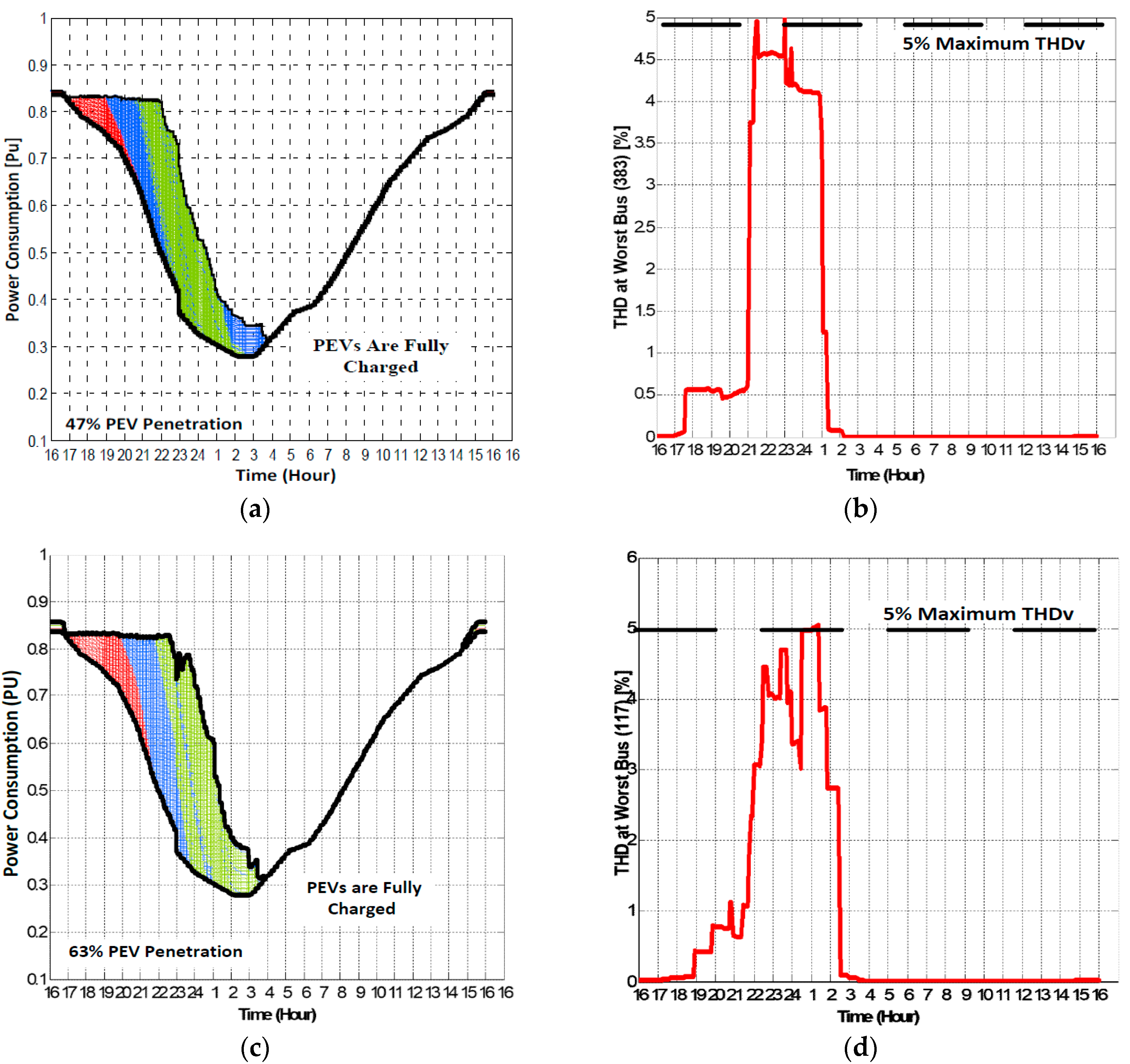
| Harmonic Order | PEV | Six-Pulse VFD | PWM-ASD | |||
|---|---|---|---|---|---|---|
| Mag. (%) | Phase (deg) | Mag. (%) | Phase (deg) | Mag. (%) | Phase (deg) | |
| 1 | 100 | 0 | 100 | 0 | 100 | 0 |
| 5 | 2 | −67 | 23.52 | 111 | 23.52 | 111 |
| 7 | 2 | −67 | 6.08 | 109 | 6.08 | 109 |
| 9 | 1.5 | −46 | 4.57 | −158 | 4.57 | −158 |
| 11 | 1.8 | −46 | 4.20 | −178 | 4.20 | −178 |
| THDi | 18.9% | 25.2% | 7.1% | |||
| Case | Simulation Results | |||||
|---|---|---|---|---|---|---|
| PEVs Charging Approach | PEV Penetration (%) | Max THDv at Worst Bus (%) | Voltage Deviations (%) | System Energy Losses (MW) | Number of PEVs Not Fully Charged | |
| 1 | Uncoordinated PEV Charging without PPFs | 16 | 5.12 | 7.64 | 0.33 | 0 |
| 32 | 6.11 | 8.50 | 0.37 | 0 | ||
| 47 | 11.60 | 13.50 | 0.44 | 0 | ||
| 2 | Coordinated PEV Charging without PPFs | 16 | 5.14 | 0.97 | 0.027 | 0 |
| 32 | 5.22 | 0.97 | 0.029 | 0 | ||
| 47 | 5.36 | 0.98 | 0.032 | 20 | ||
| 3 | Coordinated PEV Charging with PPFs | 47 | 5.02 | 0.97 | 0.028 | 0 |
| 63 | 5.02 | 0.98 | 0.029 | 0 | ||
| Item | Main Findings of This Paper (Nonlinear Online Coordination Approach) in Comparison with Previous Research | |
|---|---|---|
| This Research (Nonlinear Online Approach) | Previous Research (Online Approach) | |
| 1 | Implementation of uncontrolled PEV charging in the presence of harmonics injected by nonlinear EV battery chargers and industrial loads. | Harmonics and nonlinearities are ignored (e.g., [14,17,27]). |
| 2 | Proposing a nonlinear online PEV coordination approach (NOL-MSSCA) by using DHPF algorithm considering harmonics and THDv in the objective cost function. | Implementing a newton Raphson based power flow (PF) in the online approach. Harmonics are ignored (e.g., [17,27]). |
| 3 | Inclusion of PPFs as a practical solution to fully charge the PEVs for high PEV penetrations. | Not applicable/not used (e.g., [17,27]). |
© 2018 by the author. Licensee MDPI, Basel, Switzerland. This article is an open access article distributed under the terms and conditions of the Creative Commons Attribution (CC BY) license (http://creativecommons.org/licenses/by/4.0/).
Share and Cite
Deilami, S. Online Coordination of Plug-In Electric Vehicles Considering Grid Congestion and Smart Grid Power Quality. Energies 2018, 11, 2187. https://doi.org/10.3390/en11092187
Deilami S. Online Coordination of Plug-In Electric Vehicles Considering Grid Congestion and Smart Grid Power Quality. Energies. 2018; 11(9):2187. https://doi.org/10.3390/en11092187
Chicago/Turabian StyleDeilami, Sara. 2018. "Online Coordination of Plug-In Electric Vehicles Considering Grid Congestion and Smart Grid Power Quality" Energies 11, no. 9: 2187. https://doi.org/10.3390/en11092187
APA StyleDeilami, S. (2018). Online Coordination of Plug-In Electric Vehicles Considering Grid Congestion and Smart Grid Power Quality. Energies, 11(9), 2187. https://doi.org/10.3390/en11092187





